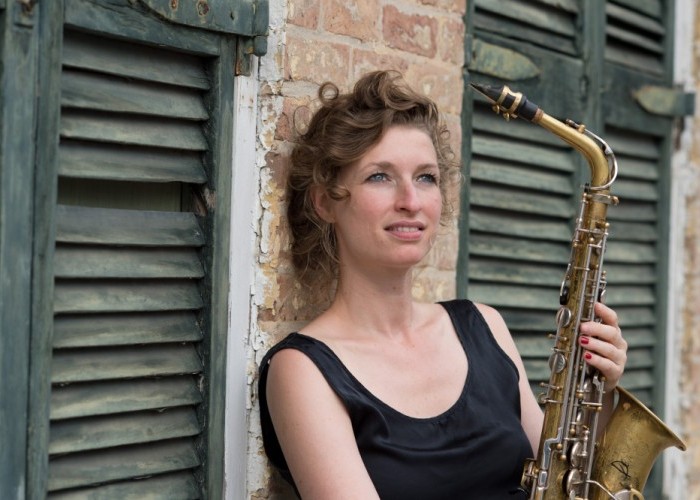Dec 9, 2025 12:28 PM
In Memoriam: Gordon Goodwin, 1954–2025
Gordon Goodwin, an award-winning saxophonist, pianist, bandleader, composer and arranger, died Dec. 8 in Los Angeles.…

Nicole Johänntgen recorded her album Henry in New Orleans, while Henry II was recorded in Zurich, Switzerland.
(Photo: Daniel Bernet)When Nicole Johänntgen was growing up in Fischbach, Germany, she routinely was awakened by her father’s New Orleans-style trombone playing.
“I’ve had that sound in my head forever,” she said in June, “and I wanted to [record] a CD with a trombone like it.”
More than two decades later, Johänntgen, 36, has done just that—twice. In the process, the alto saxophonist has built a project that honors her father, Heinrich (for whom it is named) and one that raises her international profile.
The project, so far, consists of two self-produced CDs—Henry and Henry II—that, in 15 deceptively simple tunes, meld Johänntgen’s modern melodies with a traditional New Orleans groove.
“It’s contemporary music,” said Paul Thibodeaux, who plays drums on the albums along with fellow New Orleans-based musicians Jon Ramm on trombone and Steven Glenn on sousaphone. “Nicole called us because she wanted a danceable vibe.”
For the Zurich-based Johänntgen, the project grew out of a 2016 trip to the United States. Amid a six-month stint living on New York’s Lower East Side—where she bounced between mainstream jazz and the avant-garde—she took a memorable side trip to the Big Easy.
In only a week, she corralled Thibodeaux, Ramm and Glenn, and brought them into a studio for a whirlwind session. Sustained by catfish sandwiches—the session’s “secret ingredient,” Thibodeaux said—the band cooked up enough material for the first Henry album.
The recording struck a chord among those who heard it, sparking a June 2017 tour that took the group to Germany and Switzerland. Thus seasoned, they recorded Henry II at Zurich’s 571 Recording Studios in one day. The session benefited from a heightened level of improvisatory interaction.
The group’s simpatico was reflected in the process of arranging and composing. The program consists of seven original compositions and one surprising cover: the theme song from the 1984 film Ghostbusters, arranged collectively on the fly. And while Johänntgen fashioned the other songs’ frameworks with Cubase software—retaining songwriting credit—her bandmates contributed ideas to the final product.
“I don’t think she ever told me to play a certain pattern or feel,” Thibodeaux explained.
The quartet’s music varies in tone and temperament. Henry, for example, includes both the dirge-like “Slowly”—a song about the aftermath of Hurricane Katrina—and the title tune, which recalls the “sunshine” mood her father conjured in his trombone reveille.
On Henry II, the tunes range from the kinetic “Tanzbär” (“Dancing Bear”)—which features free-jazz asides around a sousaphone line that suggests the onstage gyrations of the lithe Glenn—to the languid “Nachtspaziergang” (“Night Walk”), which was inspired by a lazy, slightly giddy post-gig perambulation in Pforzheim, Germany.
Having listened widely to saxophonists like Cannonball Adderley as a teen, Johänntgen devoted her undergraduate and graduate study to jazz saxophone, composition and arranging at a university in Mannheim, Germany.
She played in several bands, first and foremost a jazz-funk quartet founded with her brother, keyboardist Stefan Johänntgen. That band, Nicole Jo, celebrated its 20th anniversary this year with the release of 20, its seventh album. But the Henry project might be gaining more notice.
“It has opened a lot of doors for me in Germany and Switzerland,” she said, adding that it also helped her land her first gig in France. Working with Swiss and Swedish personnel, she performed the Henry repertoire at the 2018 Jazz Sous Les Pommiers festival in Coutances, Normandy.
Johänntgen also has emerged as a strong advocate for women in jazz. In 2016, she released the album Sisters In Jazz, which brought together female musicians from Sweden, Estonia, Poland, Japan and Norway. And this past March, she led the networking group Support of Female Improvising Artists in five days of workshops and performances in Zurich.
Johänntgen plans to continue working with her New Orleans-based collaborators. In October, she will bring Thibodeaux, Ramm and Glenn back to Germany and Switzerland for 11 dates—a precursor, perhaps, to further recording sessions for the Henry series.
“I hope it’s a never-ending story,” she said. DB

Goodwin was one of the most acclaimed, successful and influential jazz musicians of his generation.
Dec 9, 2025 12:28 PM
Gordon Goodwin, an award-winning saxophonist, pianist, bandleader, composer and arranger, died Dec. 8 in Los Angeles.…

Flea has returned to his first instrument — the trumpet — and assembled a dream band of jazz musicians to record a new album.
Dec 2, 2025 2:01 AM
After a nearly five-decade career as one of his generation’s defining rock bassists, Flea has returned to his first…

Belá Fleck during an interview with Fredrika Whitfield on CNN.
Jan 13, 2026 2:09 PM
The fallout from the renaming of the John F. Kennedy Center for the Performing Arts to include President Donald…

“It’s a pleasure and an honor to interpret the music of Oscar Peterson in his native city,” said Jim Doxas in regard to celebrating the Canadian legend. “He traveled the world, but never forgot Montreal.”
Nov 18, 2025 12:16 PM
In the pantheon of jazz luminaries, few shine as brightly, or swing as hard, as Oscar Peterson. A century ago, a…

Dec 11, 2025 11:00 AM
DownBeat presents a complete list of the 4-, 4½- and 5-star albums from 2025 in one convenient package. It’s a great…